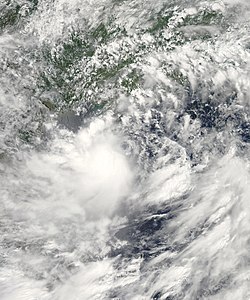 Tropical Storm Kujira at peak intensity on June 22 | |
| Meteorological history | |
|---|---|
| Formed | June 19,2015 |
| Remnant low | June 24,2015 |
| Dissipated | June 25,2015 |
| Tropical storm | |
| 10-minute sustained (JMA) | |
| Highest winds | 85 km/h (50 mph) |
| Lowest pressure | 985 hPa (mbar);29.09 inHg |
| Tropical storm | |
| 1-minute sustained (SSHWS/JTWC) | |
| Highest winds | 95 km/h (60 mph) |
| Lowest pressure | 985 hPa (mbar);29.09 inHg |
| Overall effects | |
| Fatalities | 14 total |
| Damage | $31.3 million (2015 USD) |
| Areas affected | Vietnam,China |
| IBTrACS | |
Part of the 2015 Pacific typhoon season | |
Tropical Storm Kujira was a tropical cyclone that prompted the PAGASA to declare the beginning of the rainy season in the Philippines. The ninth tropical depression,8th named storm,and first storm to make landfall on China in the 2015 Pacific typhoon season, [1] it formed as a tropical depression south of the Paracel Islands on June 19.
Contents
- Meteorological history
- Preparations and impact
- Vietnam
- China
- Hong Kong
- Elsewhere
- See also
- Notes
- References
- External links
Kujira caused 9 deaths in Vietnam due to flash flooding.

